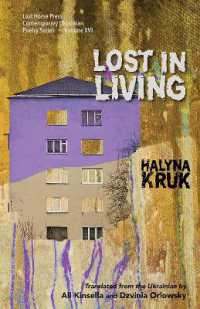基本説明
Herzog, whose Cave of Forgotten Dreams was parhaps the most celebrated documentary of 2010, maybe the most influential filmmaker missing from major studies and histories of documentary. Examining such notable films as Lessons of Darkness (1992) and Grizzly Man (2005), Eric Ames shows how Herzog dismisses documentary as a mode of filmmaking in order to creatively intervene and participate in it.
Full Description
Over the course of his career Werner Herzog, known for such visionary masterpieces as Aguirre: The Wrath of God (1972) and The Enigma of Kaspar Hauser (1974), has directed almost sixty films, roughly half of which are documentaries. And yet, in a statement delivered during a public appearance in 1999, the filmmaker declared: "There are deeper strata of truth in cinema, and there is such a thing as poetic, ecstatic truth. It is mysterious and elusive, and can be reached only through fabrication and imagination and stylization." Ferocious Reality is the first book to ask how this conviction, so hostile to the traditional tenets of documentary, can inform the work of one of the world's most provocative documentarians.
Herzog, whose Cave of Forgotten Dreams was perhaps the most celebrated documentary of 2010, may be the most influential filmmaker missing from major studies and histories of documentary. Examining such notable films as Lessons of Darkness (1992) and Grizzly Man (2005), Eric Ames shows how Herzog dismisses documentary as a mode of filmmaking in order to creatively intervene and participate in it. In close, contextualized analysis of more than twenty-five films spanning Herzog's career, Ames makes a case for exploring documentary films in terms of performance and explains what it means to do so. Thus his book expands the field of cinema studies even as it offers an invaluable new perspective on a little studied but integral part of Werner Herzog's extraordinary oeuvre.
Contents
Contents
Acknowledgments
The Minnesota Declaration
Introduction: Werner Herzog, Documentary Outsider
1. Sensational Bodies
Game in the Sand
Handicapped Future
Land of Silence and Darkness
Wodaabe
2. Moving Landscapes
The Dark Glow of the Mountains
Fata Morgana, La Soufrière
Lessons of Darkness
Wheel of Time
3. Ecstatic Journeys
Huie's Sermon
Bells from the Deep
Pilgrimage
4. Baroque Visions
The Great Ecstasy of Woodcarver Steiner
Death for Five Voices
God and the Burdened
5. Cultural Politics
Fitzcarraldo
Ballad of the Little Soldier
Ten Thousand Years Older
The White Diamond
6. Reenactments
Little Dieter Needs to Fly
Wings of Hope
Rescue Dawn
7. Autobiographical Acts
I Am My Films
Portrait Werner Herzog
My Best Fiend
Grizzly Man
Conclusion: Herzog's Vérité
Encounters at the End of the World
The Cave of Forgotten Dreams
Notes
Index








